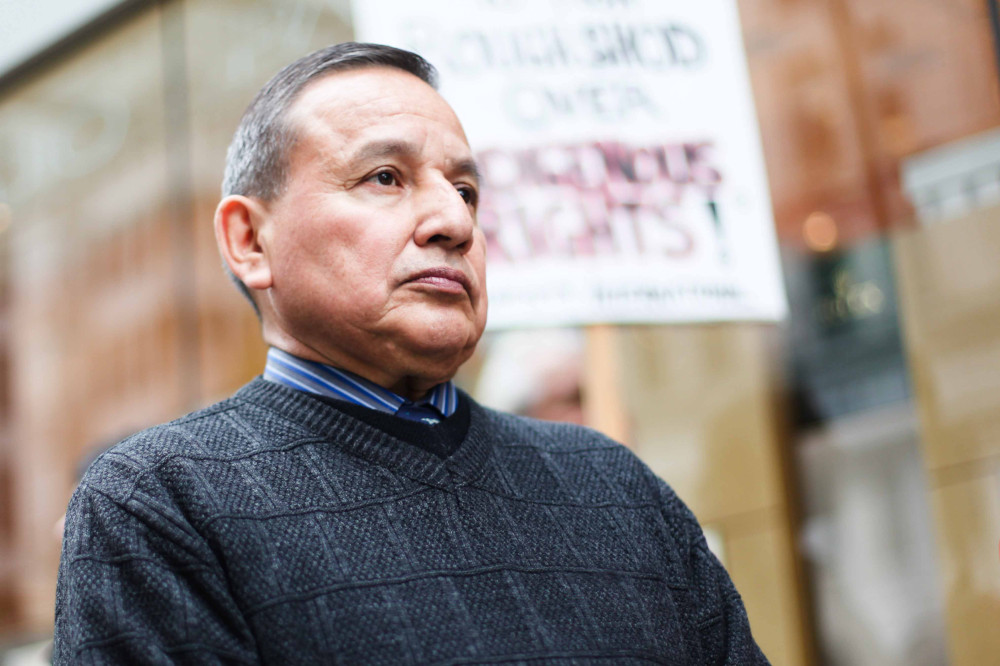Next month marks the two-year anniversary of the Trudeau government’s launch of Canada’s first-ever National Housing Strategy.
But Indigenous people, whose ancestors have lived here for tens of thousands of years, were barely mentioned, with no new funding marked solely for Indigenous housing.
This despite the fact that First Nations, Métis, and Inuit people — just five per cent of the overall population in Canada — are far more likely to live in overcrowded or unsafe housing, pay more than 30 per cent of their income on housing or become homeless.
Grand Chief Stewart Phillip of the Union of BC Indian Chiefs, an umbrella organization of First Nations governments, says the failure to address the Indigenous housing crisis is easily explained.
“It’s a dimension of racism,” he said. “And society’s attitude is ‘Indigenous people have always been poor. They’ve always lived in substandard, dilapidated housing. What would one expect? They’re Indigenous peoples,’ right?”
The Liberal government pledged in 2017 to create housing strategies for Inuit, Métis and First Nations people.
But almost two years later, there are still no Indigenous housing strategies.
Only the NDP has included such strategies in its election platform, although former Liberal MP Adam Vaughan said in a recent debate on housing that his party is “committed” to a separate national urban Indigenous housing strategy by and for urban Indigenous people.
Robert Byers, chair of the Indigenous housing caucus for the Canadian Housing and Renewal Association, an umbrella group for social and Indigenous housing providers in Canada, is not surprised by the delay.
He cites his own experience working on the national homelessness strategy released earlier this year.
“Imagine how slow something can go, and then slow it down about three or four more times,” he said, adding he understands federal policies and procedures need to be followed when creating a national strategy and that takes time. But it only accounts for some of the delay, Byers said, and he doesn’t know what else could be holding the strategy up.
Any national Indigenous housing strategies will “take a couple years” to come out, he said.
Almost 90 per cent of Indigenous people in Canada now live outside First Nations reserves, where existing federal programs provide housing for status First Nations. Depending on which Indigenous organization you ask, shortages ranging from 3,000 to 130,000 units across Canada, on and off reserve.
Nizar Laarif, director of public affairs for the Aboriginal Housing Management Association, said national strategies, including a separate funding stream for urban, rural and northern Indigenous housing — meaning off-reserve — are required to close the housing gap between Indigenous and non-Indigenous communities. The association is an umbrella group for urban and rural Indigenous housing providers in B.C.
“It’s not only the number of Indigenous people living off-reserve, but it’s also because the settings for urban or rural Indigenous people are different than the setting for the on-reserve,” said Laarif. “We’re talking economically, socially, culturally — they are different.”
The Tyee sought interviews from First Nations, Métis, and Inuit organizations about the need for Indigenous housing strategies, what they should cover and what they want to hear from candidates and parties.
But determining the cost of addressing Indigenous housing problems proved difficult. The Indigenous representatives we spoke to were reluctant to put a dollar amount on fulfilling a housing need we may not yet grasp the true depth of.
“We’re viewed in a very negative light as a drag on the economy,” Phillip said. “And there’s never been a different attitude, a different outlook in terms of seeing us as an investment.”
Urban, rural and northern Indigenous housing needs
Nearly 20 per cent of Indigenous people living in urban, rural and northern Canada have at least one housing issue: paying more than 30 per cent of their income for shelter; overcrowding; or poor dwelling conditions, according to the Canada Mortgage and Housing Corp. In comparison, 12.4 per cent of non-Indigenous people face one of those housing issues.
Scott Clark, president of the Northwest Indigenous Council representing B.C.’s urban Indigenous population, said the federal government should improve and increase urban Indigenous housing options.
“This is a crisis that should be nonpartisan amongst all political parties, and just recognize that every human being is entitled to housing as a human right,” he said.
Clark would also like to see the provinces and federal government adopt the United Nations Declaration on the Rights of Indigenous Peoples, like B.C. has pledged to do, and ensure that housing providers who receive public funding reserve a set number of units for Indigenous people.
Non-profit housing providers, including non-Indigenous social and co-op housing, could apply a “reconciliation lens” to their operations, Clark added, by prioritizing Indigenous people for government subsidized units and shuffling over-housed tenants — those units with more bedrooms than people — to make room for larger Indigenous families.
Byers, who is also CEO of the Indigenous Namerind Housing Corporation in Saskatchewan, wants the federal government to create a funding stream specific to urban, rural and northern Indigenous housing. This must include funding for new units, repairs to existing units and long-term maintenance, he says, as well as money to cover management costs.
Byers suggests the CHRA’s Indigenous caucus could receive and distribute the funding, and manage an investment fund that would provide revenue for future needs. It released its own Indigenous housing strategy last year.
“Maybe we can have some sort of Centre for Indigenous Housing and work with the feds to develop that entity, that we can look after,” he said. “I don’t think that’s too hard.”
Laarif also calls for provincial Indigenous housing entities to deliver funding, suggesting the Aboriginal Housing Management Association, which includes 41 housing providers with over 1,000 years combined experience in housing, could play that role in B.C.
Indigenous people should be part of strategy development from the beginning, he said. “Bring us to the table at the early stage, so we can co-design it together.”
On-reserve needs
In 2016, nearly half of all First Nations housing units on reserve required major repairs, while over one-third were overcrowded. In 2018, over 20 per cent of homeless people in Canada identified as First Nations.
The Assembly of First Nations estimates that 130,000 new on-reserve housing units will be required by 2031.
Comparatively, just eight per cent of non-Indigenous Canadians lived in overcrowded housing in 2017, and less than 10 per cent in homes that needed major repairs.
Stewart said the Indigenous housing crisis is far from new.
“With successive federal governments it’s never been an issue of human rights; it’s always been an issue of affordability and budget priority,” he said.
Adequate, safe housing in First Nations communities is important, Phillip said, but units should be energy efficient and off-reserve housing should also be available.
Ideally, he said, the housing crisis should be addressed by both national and provincial First Nations’ housing strategies.
The Tyee reached out to the Assembly of First Nations for comment, but it was not able to meet our deadline.
However, the organization has its own national First Nations housing strategy with a “rights-based approach” to housing, citing not only treaty rights but also UNDRIP Article 23.
“Indigenous peoples have the right to be actively involved in developing and determining health, housing and other economic and social programs affecting them and, as far as possible, to administer such programs through their own institutions,” it reads.
Like the Indigenous caucus’s strategy, the assembly calls for exploration of an investment trust as a future source of housing funding in First Nations communities; creation of a First Nation Institutional Network for Housing for distributing money; a national First Nations housing needs database; a wider variety of housing sizes and styles that meet both cultural and local climate needs; and the use of local materials and resources for new builds.
Inuit housing needs
Over half of Inuit people living in their Inuit Nunangat territory, which spans the north from what settlers call the Northwest Territories to Labrador, live in overcrowded housing. Another third live in housing in major need of repairs.
Overcrowding is linked directly to poor socioeconomic conditions and health problems: Inuit in this region are 300 times more likely to be diagnosed with tuberculosis than non-Indigenous people born in Canada.
The Tyee reached out to Inuit Tapiriit Kanatami, a non-profit organization representing over 60,000 Inuit people in Canada, for an interview but it was unable to meet our deadline.
An ITK spokesperson pointed The Tyee to the organization’s housing strategy. It calls for any federal housing investments to consider not only the region’s physical climate, but also its socioeconomic climate. Materials and labour cost more in the north; poverty rates are high; and households are larger and younger.
Direct investment in Inuit governments is also required to ensure housing needs are funded, the strategy notes. Funding through provincial and territorial governments doesn’t typically meet Inuit needs, it says.
Métis housing needs
Eleven per cent of Métis lived in overcrowded housing in Canada in 2017.
However, it was only with Budget 2018 that the federal government and Métis Nation signed an agreement that would provide the national organization with $500 million over 10 years for the design, delivery and administration of Métis housing.
The Tyee reached out to both the Métis Nation and its provincial affiliate, Métis Nation British Columbia, for interviews. Neither responded to our inquiries.
However Keith Henry, president of the BC Métis Federation, which split off from Métis Nation British Columbia in 2011, says the Métis housing providers that do exist in B.C. aren’t connected with the federation and its members.
“It’s just really hit and miss,” said Henry, adding that affordable housing is one of the non-profit’s top challenges. “We find service providers often want to say that they represent the community, but there’s no meaningful relationship and that’s a very big concern to us.”
BC Métis Federation hopes to work with CMHC to commission an updated study on its members’ housing needs, but Henry said it’s still in the early stages of finalizing a deal.
Henry would like to see a national Métis housing strategy, adding that although more data is needed he knows his members face the same housing challenges as other Indigenous communities, including unaffordable, overcrowded and unsafe housing, and homelessness.
But he cautions against whoever forms the next federal government from creating a single pan-Indigenous housing strategy.
“If we have Métis elders [housing], we want to make sure that it’s Métis culture that’s part of what’s being represented in these facilities,” he said.
“We think it’s a great idea to have services, but often what happens with these Indigenous housing projects is it gets dominated by local Indigenous culture, and it’s not always Métis inclusive.” ![]()
Read more: Election 2019, Indigenous, Housing


















Tyee Commenting Guidelines
Comments that violate guidelines risk being deleted, and violations may result in a temporary or permanent user ban. Maintain the spirit of good conversation to stay in the discussion.
*Please note The Tyee is not a forum for spreading misinformation about COVID-19, denying its existence or minimizing its risk to public health.
Do:
Do not: